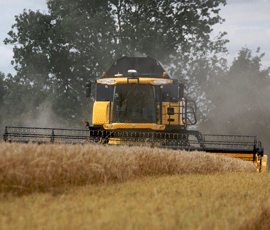Harvest 2012: First barley combined

The first barley of 2012 has been harvested as growers took advantage of a break in the clouds to grab crops before more rain hit southern England.
Somerset farmer Gerald Addicott and daughter Emily were harvesting winter barley at Corston Fields Farm, near Bath, on Sunday (15 July).
A poor weather forecast for the week ahead meant the crop was harvested in less than ideal conditions, with a moisture content of 21% at 2pm.
“The forecast for this week is terrible again,” Emily wrote on Twitter. “We decided to get on regardless.”
Exact yield was unknown, but there was “plenty of it” and plenty of straw, she added.
Barley grown on the farm’s Cotswold brash soils are usually among the first in the area to be harvested, but some of the heavier land is still a week or so away.
“It’s desperate now,” said Emily. “[We’re] cutting barley that needs about four days sun on it first. Rain, rain and more rain.”
On the eastern side of the country, barley yielding about 10t/ha (4t/acre) was photographed by Chris Lockwood as it was harvested for cattle feed at 24% moisture.
It came as the HGCA confirmed strong forward prices and good planting conditions had been offset by concern over the effect of wet weather on yields.
The total GB area for wheat, barley, oats and oilseed rape for this harvest is estimated at 3.810m hectares, up 3% on 2011 and similar to levels seen in 2008.
These area gains are likely to have come from reductions in other crops such as pulses.
But recent wet weather has cast doubts over final yields, according to AHDB Market Intelligence.
Senior analyst Jack Watts said: “Strong GB forward prices at planting time, combined with good planting conditions in England, are most likely to be behind the increase in planted area.
“Although Scotland saw a wet autumn, the weather was much more favourable in March this year, which enabled farmers to plant more spring barley in place of winter wheat.
“However, weather for developing crops has been poor over recent weeks, with low sunshine levels and high rainfall during the critical grain filling period. As a result, uncertainty remains around yields.
“This is particularly true for oilseed rape, which has seen record GB planting levels, which may not translate into record production.”
Some 17% of the GB wheat area is estimated to be planted to Nabim Group 1 varieties, 9% to Group 2, 21% to Group 3 and 52% to Group 4.
Comparing 2012 to 2011, at the GB level, the area share among the four Nabim groups is relatively static, with a decline in Group 2 and an increase in Group 3 this year.
Regional variation in varieties is large – mainly due to increasing specialisation among growers.
For barley, 67% of the GB area is estimated to be planted to malting type varieties.
DK-Cabernet and Excalibur appear to be the most popular GB oilseed rape varieties, accounting for an estimated 21% and 12% of the GB area respectively.

